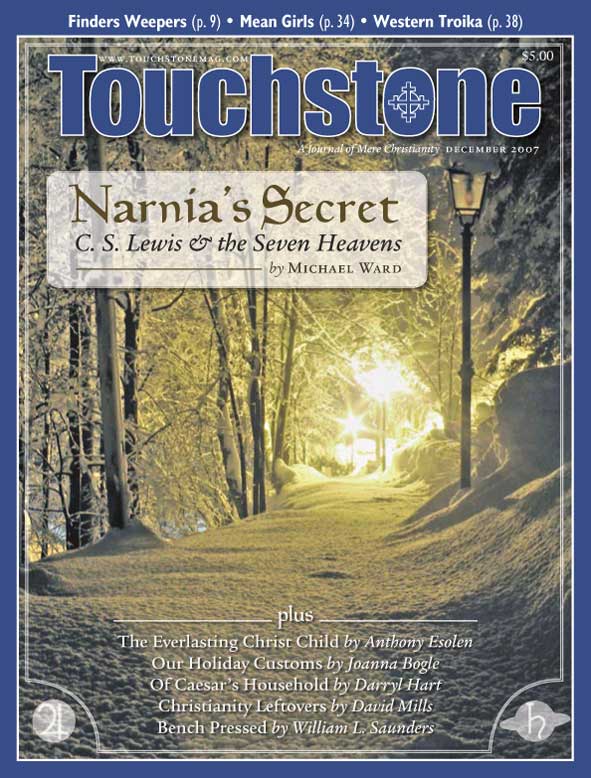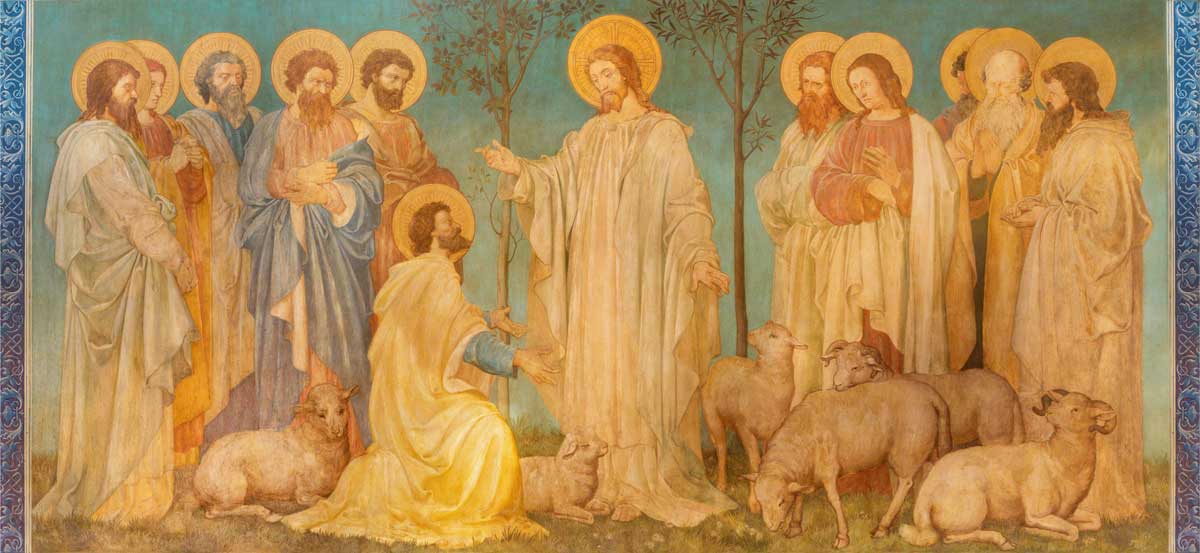Leftovers
Christianity for the Rest of Us: How the Neighborhood Church Is Transforming
the Faith
by Diana Butler Bass
HarperSanFrancisco, 2006
(321 pages, $23.95, hardcover)
reviewed by David Mills
Mainline Christianity in the middle twentieth century became an “establishment religion” that “traded open questions for easy answers—their own,” writes the Episcopal historian Diana Butler Bass in Christianity for the Rest of Us. By the 1960s it had become “self-absorbed and secular.” Liberals had “lost their sense of wonder, transcendence, and passion,” and this helps explain the success of the conservative Protestant response.
She proposes an alternative, “something happening in the pews . . . that could transform American Christianity.” Judging from the blurbs on the cover, mainline leaders from the archbishop of Canterbury to Jim Wallis to Marcus Borg seem to have read the book with relief.
A Village Answer
Diana (the author is the godmother of our second child, and though we have since gone in different directions, we remain friends) spent three years, funded by the Pew Foundation, traveling the country studying mainline churches “that have found new life in the face of change.”
She proposes a new “village church” that provides “a spiritual community, a home, where they [its members] could forge new, non-biological family ties with a religious tradition.” It holds to the tradition in ways the old mainline liberalism did not, but unlike conservatism uses it “in ways that are open, fluid, flexible, and dynamic.”
This “emerging” or “transformative” mainline Christianity “is open and generous, intellectual and emotive, beautiful and just . . . creative and traditional, risk-taking and grounded, confident and humble, open and orthodox.” It “emphasizes open practice instead of purity.” It descends from “ancient wisdom,” is an “old kind of Christianity.”
These Christians “rest comfortably with ambiguity” and “resist dogmatism in favor of being part of a community where they can ask life’s questions.” For them, “thinking theologically did not mean arriving at certain conclusions” (she means “certain” in both senses, particular and definite).
These are oft-repeated themes, and nowhere in the book does she define this kind of Christianity any more concretely or lay out its doctrinal and moral foundation. She is clear, however, about what it is not.
It is not the religion of those “who build churches to protect people from change,” who “venture out into the world to try and force the rest of us back to the perfect world of their fathers,” who “prefer to build walled villages and do not want to see.” It is not “exclusivist Christianity,” which promotes “a political agenda . . . from the religious right.” What I would call traditional Christianity is never once described in a complimentary or respectful way.
Vital Liberalism
The body of the book surveys what Diana calls the “practices” of these village churches, which she lists as hospitality, discernment, healing, contemplation, testimony, diversity, justice, worship, reflection, and beauty.
“Practices” are communal actions that “point Christians in the right direction, toward the wisdom of God, toward love, toward home.” Each is described through the life of congregations she visited. What makes them Christian practices, and how the practices form Christians instead of something else, is never explained.
The chapter on “testimony,” for example, describes churches that have members tell their stories during the service and the ways this practice changed them. But these are not old-fashioned testimonies: They “no longer tell tales of spiritual acquiescence and conformity. Rather, they tell of finding meaning, finding unique selves, and finding God in a confusing and chaotic world.”
The churches she observes range from a musically sophisticated Congregationalist church in New Haven to a small-town Presbyterian church in Pennsylvania that offers the services of a Reiki instructor to an Episcopal parish in California with a homosexual pastor and lots of students from a nearby Evangelical college. Many were almost dead before the changes she describes. They are generally small, with the lowest attendance 130 and the highest 660.
Limited Success
For all its interest as a well-written survey of innovative and lively forms of mainline Protestantism—and I should say that the churches she describes are often very attractive communities — Christianity for the Rest of Us does not necessarily provide the hope that mainline leaders crave, because, being almost entirely descriptive, it does not examine deeply enough the sources of those churches’ success.
These churches enjoy all the benefits of being a mainline church: a building, a tradition, an endowment, a pension fund for the clergy, a social status, and a name brand (even seekers look for brand names). Most are small and in urban and suburban areas with middle-class populations of the sort to whom this kind of religion appeals.
Many were dying and therefore easier for a determined leader to change. In fact, the nature of the necessary leadership is a subject Diana does not address nearly enough. From the stories she tells, it is clear that despite all the churches’ talk about the community and their dislike of traditional hierarchies, most depended upon a creative and forceful leader to become what they are now, and perhaps to remain what they are.
And judging simply from the testimonies she quotes, I wonder how many of them depend for their vitality on ex-Evangelicals and ex-Catholics (“spiritual refugees”) who (“escaping more literalist traditions”) brought religious knowledge, fervor, and commitment with them, and how vital they would be if that supply were cut off. They appeal to many because of what they are not, and a shared antipathy to “fundamentalists” seems to bind these groups more tightly together.
The book rarely mentions the question of sexual morality, despite its importance in the mainline world. It is an analytical elephant in the room, because one naturally asks how much do these churches appeal because they do not insist upon a traditional Christian sexual discipline but offer all the other benefits of religion? How much do they appeal because they lower the price of commitment at a point of most practical effect? It is much easier to create an affirming community when you praise people for doing what they want.
In other words, their congregations are self-selected in a way many Evangelical churches are not, and indeed in a way the old mainline churches were not. They are, as the joke goes, the sort of thing you like if you like that sort of thing.
These churches have succeeded in part because they have retreated from the vision of universality that animated the old mainline and become a niche product for a specialized market, though that market—for what might be called “Christianity Lite”—may be quite big. But whether other churches without their advantages can replicate their success is a question the book does not address, which reduces their value as a source of hope for the mainline in general.
The Christian Problem
But I think that there is a much deeper problem with the book, and that is its use of “Christianity.”
The churches Diana describes take for granted the Christian doctrinal and moral tradition, while using it as a resource rather than an authority. Some members believe it, for the most part (the doctrine more than the morals, I suspect), while for others it seems to be the story by which they choose to understand their world. In both cases it provides the needed intellectual foundation and orientation, and the necessary story, but with usefully uncertain and variable content.
They have a dogma, but its explicit content is either entirely negative, in not being narrow, rigid, fundamentalist, and so on, or general, in appeals to the Christian story as healing, affirming, and so on. You will not find, if the book and my own observation are correct, anyone getting from the story told in the Gospels to St. Paul’s more unfashionable instructions.
Traditional church people, Diana writes, concerned with doctrine, “often pit the mind against the heart.” I suppose some do, but she does not seem to notice how often the people she praises pit the heart against the mind. The dozens of people she quotes generally explain their faith in subjective, personal terms, speaking of what they did not like in their childhood churches, of how they feel and what makes them happy.
They establish their connection with the Christian tradition in the now time-honored way. Many of them invoke “the Spirit” or “the Holy Spirit” and speak of this spirit as a divine and directive power. (Their appeal to the Christian tradition is selective: No one quoted in the book speaks of “the Father” or refers to Jesus as “the Son” or “the Lord.”)
How they understand this spirit and distinguish its instructions from feelings, instincts, and tastes they would have anyway is not explored. I don’t think the word “revelation” ever appears in the book.
Diana deals with the problem indirectly by an appeal to change. “The Christian faith always changes,” she argues more than once. The response to this, as with many statements in the book, can only be “yes and no.”
But if it is true in the sense she means it, what keeps it Christian through all the profound changes she describes? What keeps it from becoming something else? Where is the line? What forces these Christians to accept the insights of the faith that are to their eyes primitive, absurd, outdated, or irrelevant? What makes it a corrective as well as an encouraging faith?
The book does not answer these questions, I think because Diana’s real subject is not Christianity but the mainline churches as religious institutions, with “Christian” understood as what-ever they do. I do not think she intended to do so, but it is the almost inevitable result of failing to answer the doctrinal questions and of her entirely descriptive method.
The Catholic modernists of the last century wanted to preserve the Church by removing everything in it they thought offensive to modern belief, which meant nearly everything that distinguished it from a spiritually minded secularism. All they kept was the institutional arrangements. At some point, people will ask “Why bother, then?” and this Diana’s village churches will not avoid.
The Opposite Effect
Christianity for the Rest of Us seems to me to prove the opposite of what it intends: that there is no positive “Christianity for the rest of us,” only a diluted version of what Diana might call “Christianity for Them,” depending for its life on the facilities and status and traditions it inherited and thereby being able to offer people a recognizably Christian spiritual experience and corporate validation on much reduced terms.
Even diluted, the faith still moves hearts and minds, and many of those hearts and minds may never make it to something more definite. The story of Jesus changes lives, even of those who want to “live it in community” while believing it only a myth.
But diluted Christianity can also inoculate people against the real thing, and at best it does not give sinful and suffering people a strong enough dose of the medicine they need. Diana would disagree with this, thinking the medicine a poison, but the answer to our disagreement depends on questions of truth she does not address.
That said, the book treats seriously cultural challenges that many Evangelicals and Catholics foolishly ignore and others pander to, both taking false comfort in the chaos and division of mainline Christianity.
Diana is right to see the hope for the future in revitalized local churches that understand themselves as intentional communities, and the pictures she draws of such churches force traditional Christians to ask why, when these churches are so doctrinally inadequate, they often do so much better in practice. There is much in this book that the pastor (whether he pastors a local church or a group of churches) will ponder, and much that he might adopt.
But all that she praises can be done more successfully when pursued with the full resources of the Christian tradition. The great tradition she dismisses without ever engaging is far more supple and adaptable than she allows, however rigid and brittle some traditional Christians may be.
And because it declares certain truths to be true for all, it is a one-size-fits-all religion that can be sold in every market. By being narrow and rigid it can be broad and flexible. Traditional Christianity is a Christianity for All of Us, indeed the only effective Christianity for all of us.
David Mills has been editor of Touchstone and executive editor of First Things.
subscription options
Order
Print/Online Subscription

Get six issues (one year) of Touchstone PLUS full online access including pdf downloads for only $39.95. That's only $3.34 per month!
Order
Online Only
Subscription

Get a one-year full-access subscription to the Touchstone online archives for only $19.95. That's only $1.66 per month!
bulk subscriptions
Order Touchstone subscriptions in bulk and save $10 per sub! Each subscription includes 6 issues of Touchstone plus full online access to touchstonemag.com—including archives, videos, and pdf downloads of recent issues for only $29.95 each! Great for churches or study groups.
Transactions will be processed on a secure server.
more from the online archives
calling all readers
Please Donate
"There are magazines worth reading but few worth saving . . . Touchstone is just such a magazine."
—Alice von Hildebrand
"Here we do not concede one square millimeter of territory to falsehood, folly, contemporary sentimentality, or fashion. We speak the truth, and let God be our judge. . . . Touchstone is the one committedly Christian conservative journal."
—Anthony Esolen, Touchstone senior editor









